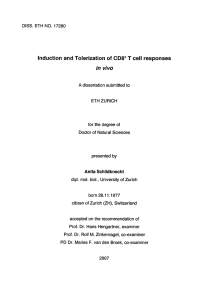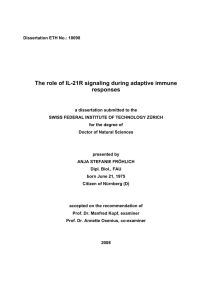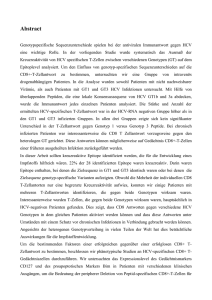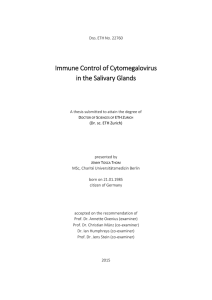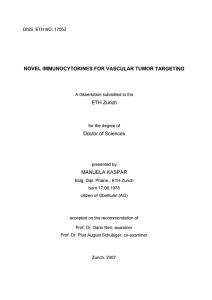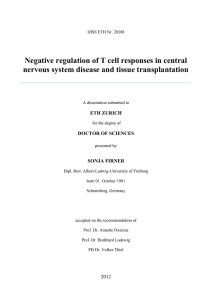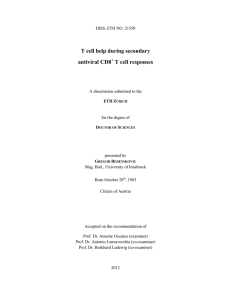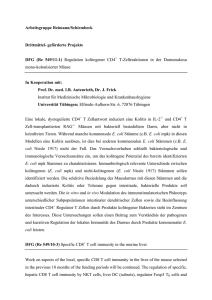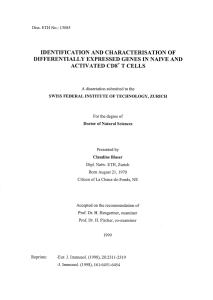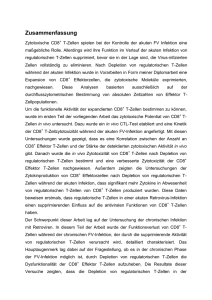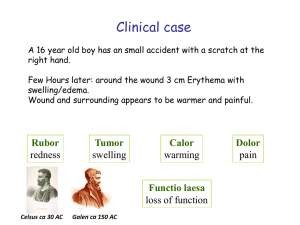Mathematical modeling of cellular immune - ETH E
Werbung
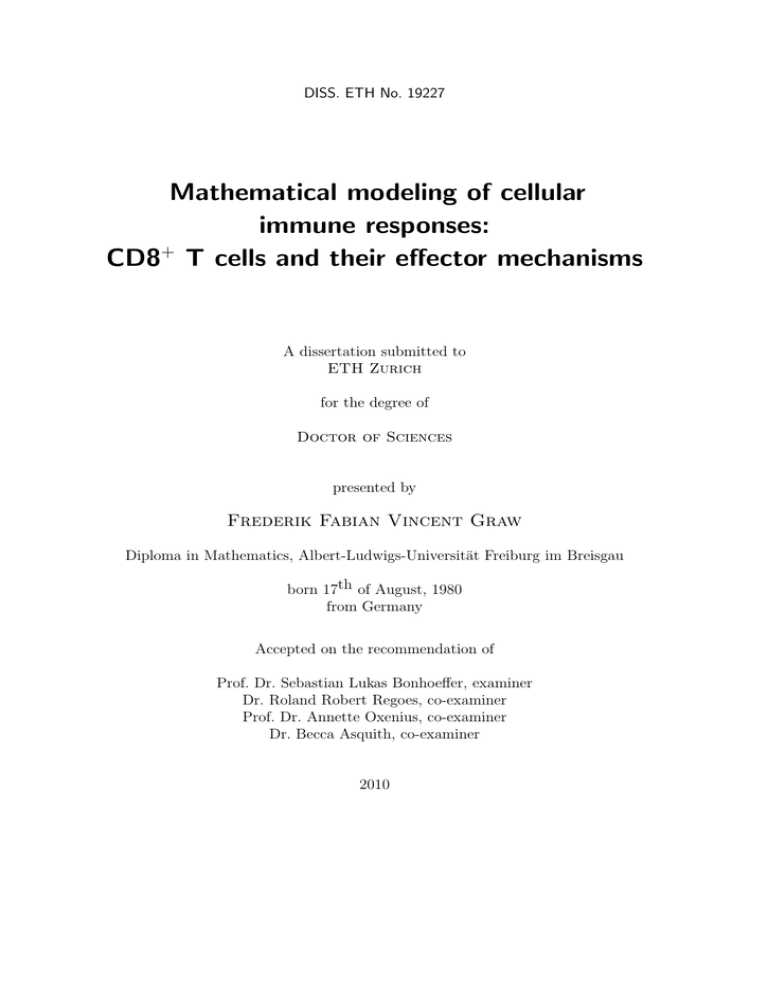
DISS. ETH No. 19227 Mathematical modeling of cellular immune responses: CD8+ T cells and their effector mechanisms A dissertation submitted to ETH Zurich for the degree of Doctor of Sciences presented by Frederik Fabian Vincent Graw Diploma in Mathematics, Albert-Ludwigs-Universität Freiburg im Breisgau born 17th of August, 1980 from Germany Accepted on the recommendation of Prof. Dr. Sebastian Lukas Bonhoeffer, examiner Dr. Roland Robert Regoes, co-examiner Prof. Dr. Annette Oxenius, co-examiner Dr. Becca Asquith, co-examiner 2010 Zusammenfassung Unser Immunsystem ist in der Lage, eine Vielzahl von unterschiedlichen Krankheitserregern frühzeitig zu erkennen und zu bekämpfen. Neben unspezifischen Abwehrmechanismen des sogenannten angeborenen Immunsystems, greift es dabei auf eine Reihe von Zellen und Faktoren zurück, die sich speziell gegen den eingedrungenen Erreger richten. Zu diesem adaptiven Immunsystem gehören die CD8+ T Zellen. Einmal aktiviert, können sie mit Hilfe ihrer T-Zell Rezeptoren infizierte Zellen erkennen und gezielt töten. CD8+ T Zellen sind mitentscheidend für die erfolgreiche Bekämpfung von Infektionen. Gerade in persistenten Infektionen, in denen das Immunsystem den Krankheitserreger nicht vollständig eleminieren kann, wie bei Infektionen mit HIV oder dem Hepatitis C Virus, scheint die Funktion dieser Immunzellen beeinträchtigt zu sein. In dieser Arbeit werden verschiedene Aspekte der CD8+ T Zell-Immunantwort speziell im Hinblick auf ihre Dysfunktionalität in persistenten Infektionen untersucht. Dabei werden verschiedene mathematische Modelle und Simulationen in Kombination mit experimentellen Daten verwendet. Kapitel 2 und 3 beschäftigen sich mit der Quantifizierung der zytotoxischen Effektiviät der CD8+ T Zellen. In Kapitel 2 untersuche ich die Eignung verschiedener mathematischer Modelle zur Auswertung entsprechender Experimente mit Hilfe einer 3D Computersimulation des experimentellen Systems. In Kapitel 3 wird dann die zytotoxische Effektivität von CD8+ T Zellen in akuten und persistenten Infektionen innerhalb eines Maus-Experiments verglichen. Die Analyse der Daten mittels einer angepassten Version des bereits in Kapitel 2 vorgestellten Modells zeigt, dass die Zytotoxizität der CD8+ T Zellen in persistenten Infektionen nur unwesentlich beeinträchtigt ist. Neben ihrer Zytotoxizität besitzt eine CD8+ T Zelle weitere Funktionen, um die Ausbreitung einer Infektion zu bekämpfen. Dazu gehören Mechanismen, die das Eindringen des Krankheitserregers in die Zelle verhindern oder auch solche, die die Produktion von neuen Pathogenen in infizierten Zellen unterbinden, ohne die infizierte Zelle selbst zu zerstören. In Kapitel 4 untersuche ich mit Hilfe eines theoretischen Modells am Beispiel von HIV, in wieweit eine therapeutische Verstärkung dieser verschiedenen Faktoren zur v vi Contents Kontrolle und Bekämpfung der HIV-Infektion beitragen kann. Wie schon in Kapitel 3 zeigt sich, dass der Verlust nicht-zytotoxischer Effektormechanismen der CD8+ T Zellen eine wesentliche Rolle in der Etablierung persistenter Infektionen spielen kann. Trotz ihrer geringen Populationsgröße zu Beginn einer Infektion sind CD8+ T Zellen in der Lage, rasch und effektiv auf ein eindringendes Pathogen zu reagieren. In Kapitel 5 wird untersucht, in wieweit eine intakte Anatomie der lymphatischen Organe, in denen sich CD8+ T Zellen vorzugsweise aufhalten, dabei hilft. Simulationen mittels eines 3D Computermodells zeigen, dass die Zerstörung eines für die Fortbewegung von T-Zellen wichtigen Netzwerkes, wie wir es in verschiedenen persistenten Infektionen beobachten können, die Kontaktwahrscheinlichkeit zwischen Immunzellen und ihren Gegenspielern erheblich beeinträchtigt. Neben ihren Funktionen, die die direkte Bekämpfung von Pathogenen erlauben, tragen CD8+ T Zellen auch zum Schutz vor erneuten Infektionen mit ein und demselben Pathogen bei. Eine größere Ausgangspopulation von Zellen als noch vor der ersten Infektion ermöglicht eine noch schnellere und effektivere Immunantwort. Die Entwicklung und Evolution dieses immunologischen Gedächtnisses ist bis heute noch nicht vollständig geklärt. In Kapitel 6 untersuche ich, inwieweit die Fähigkeit eines Individuums sich vorangegangene Infektionen zu merken, seine Fitness in unterschiedlichen Pathogenumgebungen beeinflusst. Mit Hilfe eines individual-basierten Modells können dabei Parameter identifiziert werden, die die Ausprägung von bestimmten Gedächtnistypen mit beeinflussen. Summary Our immune system is able to rapidly recognize and fight a large number of various pathogens. Besides unspecific immune mechanisms of the so called innate immune system, it uses several types of cells and soluble factors, which are specifically adapted to the invading pathogen. CD8+ T cells belong to this adaptive immune system. Once activated, they recognize infected cells by their T cell receptors and kill these cells to prevent the spread of infection. CD8+ T cells are essential to clear pathogens effectively. Especially in persistent infections, in which the immune system is not able to clear the pathogen completely, as e.g. in infections with HIV or the hepatitis C virus, the functionality of this cell type seems to be impaired. In this thesis, I investigate different aspects of the CD8+ T cell response, especially with regard to their dysfunctionality in persistent infections. Thereby, I use mathematical models and simulation tools in combination with experimental data. Chapter 2 and 3 deal with the quantification of the cytotoxic efficacy of CD8+ T cells. In chapter 2, I investigate the appropriateness of several mathematical models, which are used for the analysis of related experimental data, with the help of a 3D computer simulation of the experimental assay. In chapter 3, I then compare the cytotoxic efficacy of CD8+ T cells in acutely and persistently infected mice. Analysis of the data with an adapted version of the mathematical model already presented in chapter 2 reveals that the cytotoxicity of CD8+ T cells in persistent infections is only slightly impaired. Besides cytotoxicity, CD8+ T cells are capable of several other effector mechanisms to fight infections. These comprise molecules which either prevent pathogens from entering cells or inhibit the production of new pathogens by infected cells without destroying the infected cell. In chapter 4, I investigate to what extent therapeutic interventions for these effector mechanisms contribute to the control and development of an HIV infection using a theoretical model. As already seen in chapter 3, the analysis reveals that the loss of non-cytolytic effector mechanisms of the CD8+ T cells could play an essential role in the establishment of persistent infections. Although the population of specific CD8+ T cells is rather small at the beginning of vii viii Contents an infection, they are able to act rapidly and effectively against an invading pathogen. Chapter 5 investigates to what extent the intact anatomy of lymphoid organs, in which CD8+ T cells are preferentially located, supports this effective response. Simulations in a 3D computer model show that the disruption of a network, which is important for the motility of T cells inside the lymphatic organs, impairs the contact probability between immune cells and their counterparts. Besides their capability to fight infections directly, CD8+ T cells also contribute to the protection against a reinfection with the same pathogen. Due to a larger number of cells than compared to the situation before the first infection, they can mount an even more rapid and more effective immune response. The development and evolution of this immunological memory has not been fully understood, yet. In chapter 6, I investigate to what extent the capability of an individual to remember previous infections affects its fitness with regard to different pathogen environments. Using an individual-based model, I can identify parameters which favour the development of different types of immunological memory.
